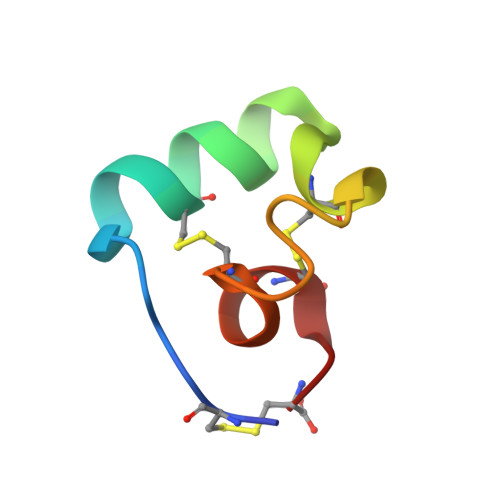Synthesis, folding, structure and activity of a predicted peptide from the sea anemone Oulactis sp. with an ShKT fold.
Krishnarjuna, B., Villegas-Moreno, J., Mitchell, M.L., Csoti, A., Peigneur, S., Amero, C., Pennington, M.W., Tytgat, J., Panyi, G., Norton, R.S.(2018) Toxicon 150: 50-59
- PubMed: 29772211
- DOI: https://doi.org/10.1016/j.toxicon.2018.05.006
- Primary Citation of Related Structures:
6BUC - PubMed Abstract:
Sea anemone venom is rich in bioactive compounds, including peptides containing multiple disulfide bridges. In a transcriptomic study on Oulactis sp., we identified the putative 36-residue peptide, OspTx2b, which is an isoform of the K V channel blocker OspTx2a (Sunanda P et al. [2018] Identification, chemical synthesis, structure and function of a new K V 1 channel blocking peptide from Oulactis sp. Peptide Science, in press). As OspTx2b contains a ShK/BgK-like cysteine framework, with high amino acid sequence similarity to BgK, we were interested to investigate its structure and function. The solution structure of OspTx2b was determined using nuclear magnetic resonance spectroscopy. OspTx2b does indeed possess a BgK-like scaffold, with the same disulfide bond connectivities. The orientation of the Lys-Tyr dyad in OspTx2b is more similar to that in ShK than in BgK. However, it failed to show against a range of voltage-gated potassium channels in Xenopus oocytes and human T lymphocytes. OspTx2b also showed no growth inhibitory activity against several strains of bacteria and fungi. Having a BgK-like fold with the Lys-Tyr dyad but no BgK-like activity highlights the importance of key amino acid residues in BgK that are missing in OspTx2b. The lack of activity against the K V channels assessed in this study emphasises that the ShK/BgK scaffold is capable of supporting functional activity beyond potassium channel blockade.
Organizational Affiliation:
Medicinal Chemistry, Monash Institute of Pharmaceutical Sciences, Monash University, 381 Royal Parade, Parkville, VIC 3052, Australia.














